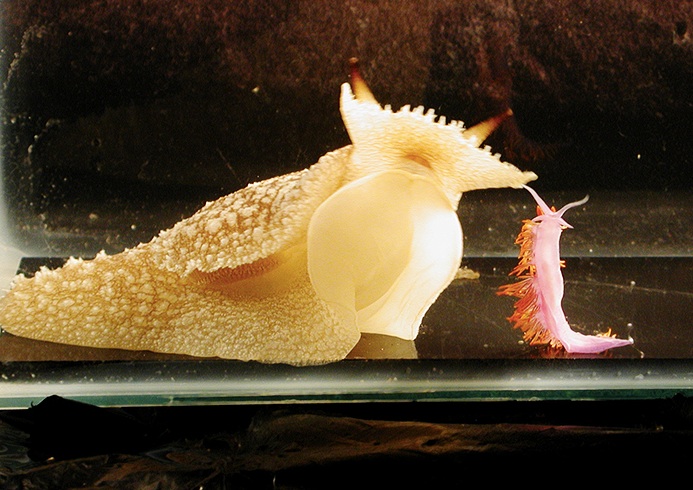Cool Video: Sea Slug Dance Reveals Primitive Learning

An attempt by one slug species to eat another ends in a flamboyant dance by the potential prey — and in a learning experience for the hungry predator.
A new video shows this interaction, which reveals that the predator sea slug, Pleurobranchaea californica is cleverer than previously believed. The slug, which generally eats anything it can get its mouth around, can learn to avoid nasty prey, according to new research published online in May in the Journal of Experimental Biology.
"If you’re a generalist like Pleurobranchaea, it's highly strategic and advantageous to learn what's good and what's not good so you can decide whether or not to take the risk of attacking certain types of prey," study researcher Rhanor Gillette, a physiologist at the University of Illinois, said in a statement.
Gillette first realized Pleurobranchaea's primitive learning abilities when he was demonstrating to a laboratory visitor how the slug slurps down other sea slugs. He placed a vivid purple-and-black sea slug known as a Spanish shawl (Flabellina iodinea) into an aquarium with the larger, predatory Pleurobranchaea.
The Pleurobranchaea quickly went in for the kill, sniffing and then biting the Spanish shawl. But the Spanish shawl has a trick up its sleeve: The species eats a jellyfish-like animal called Eudendrium ramosum and integrates the creature's stinging cells into its own body.
When the Pleurobranchae bit down, it got a mouthful of stingers, causing it to spit out the Spanish shawl, which in turn went into a frenzy of flapping, a "dance" that is meant to help the shawl escape predators. Meanwhile, Pleurobranchae turned around and made a beeline in the opposite direction. [See Video of the Dance & Failed Slug Attack]
Intrigued, Gillette put the Spanish shawl back into the aquarium a few minutes later. This time, the predatory Pleurobranchae took nothing more than a sniff before turning its back on the potential snack.
Sign up for the Live Science daily newsletter now
Get the world’s most fascinating discoveries delivered straight to your inbox.
"I had never seen that before!" Gillette said. "We began testing them and found that they were learning the odor of the Spanish shawl very specifically and selectively."
In fact, when the researchers exposed Pleurobranchae to Spanish shawls in a controlled training area, they found those that had already been fed a great deal ignored the potential meal, being full already. Those that had been on a restricted diet and were ravenous took the risk and chowed down on the stinging Spanish shawls regardless of the stinging. But those that were neither starving nor stuffed were selective. These slugs continued to avoid the Spanish shawls by scent. They would eat a nearby and nearly identical-looking species of sea slug without hesitation.
"Finding this highly selective type of learning enlarges our perspective of function, in terms of the animal's ability to make cost-benefit decisions, that place it on a rather higher plane of cognitive ability than previously thought for many sea slugs," Gillette said.
Follow Stephanie Pappas on Twitter and Google+. Follow us @livescience, Facebook & Google+. Original article on LiveScience.com.

Stephanie Pappas is a contributing writer for Live Science, covering topics ranging from geoscience to archaeology to the human brain and behavior. She was previously a senior writer for Live Science but is now a freelancer based in Denver, Colorado, and regularly contributes to Scientific American and The Monitor, the monthly magazine of the American Psychological Association. Stephanie received a bachelor's degree in psychology from the University of South Carolina and a graduate certificate in science communication from the University of California, Santa Cruz.









